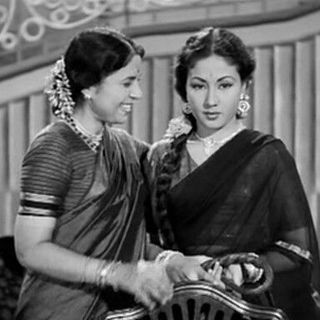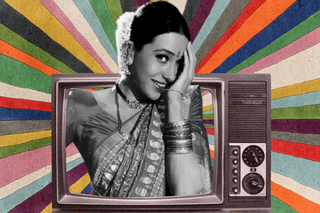
Can We Move On: From the Trope of the Woman Who Perfectly Balances Sanskaar and Sexiness
More than two decades since the release of ‘Biwi No. 1,’ we continue to idolize women who achieve the impossible.

In Can We Move On, we revisit old tropes and question whether they have any remaining cultural relevance.
“Sundar ho aur sushila… fashion bhi jaane… ho Sita jaise naari… [She should be pretty but also good-tempered… She must be fashionable… She should be like Sita (from Ramayan)…]”
If you think they’re lines from a matrimonial ad, you’re mistaken. These are the lyrics of a song that sets the tone for Mere Brother Ki Dulhan (2011), a big-banner Bollywood movie about a man looking for the “ideal” bride for his elder brother. The lyrics double up as his checklist — and a rather long one at that. Although the fact that it sounds eerily similar to matrimonial ads is rather telling of what the Indian society expects from women in heterosexual partnerships.
Kush, played by Imran Khan, sings about his expectations from his future bhabhi: she must be like a “model;” must not be “lazy” about performing her duties; and must not have an “ego.” Basically, the woman must be “sugar, spice, and everything nice” in order to be considered a suitable match for Kush’s brother, Luv. Interestingly, however, Luv is in love with an entirely different person, in the meantime, whom he eventually elopes with.
If Kush hadn’t been so focused on creating a sexist catalog, maybe, he would’ve had the chance to figure out his brother was missing the basic quality of honesty, which, arguably, is important to sustain any relationship. But would that have mattered in a world where we believe men are, by nature, wired to cheat if their female partners don’t embody just the right balance between sexy and sanskaari?
In 1999’s superhit movie Biwi No. 1, we see Salman Khan’s character (whom I shall henceforth refer to as “Pendulum”) leaving his wife for a model because she was so sanskaari, she forgot to be sexy enough. Although he calls her beauty intoxicating; her body, lighter than a flower; and her walk electrifying like lightning — it doesn’t stop him from cheating on her just a few scenes later. Why? Because she was so caught up in singing bhajans, performing domestic chores, caring for his mother, and parenting their children that she couldn’t find the time to whisper sweet nothings to him on the phone.
Related on The Swaddle:
Can We Move On: From The Long‑Suffering Woman Trope As A Vehicle To Highlight Men’s Virtues
To prevent him from seeking affection elsewhere — as though his philandering were justified — his mother good-naturedly advises his wife: “Tu uski premika ban, biwi nahi [Be his lover, not his wife].” Yet, eventually, he leaves his “lover” Rupali too — because she never managed to be as sanskaari as his wife, who has, by now, worn enough mini skirts to convince him she is capable of balancing her sanskaar with sexiness. So, naturally, Pendulum swings back to her.
Unfortunately, we forgot to leave behind Pendulum’s expectations of women as we made our way into the 2000s — or even the 2010s. In 2018’s Veere Di Wedding, a man chooses to divorce his wife because she, too, failed to find the perfect balance between sexiness and sanskaar. Like Rupali, she lacked sanskaar because why else would she dare to masturbate in the privacy of her own bedroom?
Filmmakers in Bollywood are obsessed with this trope, which is essentially the desi iteration of “lady in the streets, freak in the sheets.” From Tina in Kuch Kuch Hota Hai to Poo in Kabhi Khushi Kabhie Gham, leading ladies of Hindi cinema seamlessly switch between “sexy woman” to “sanskaari wife” — mostly by exhibiting their bhajan-singing abilities to prove their sanskaar. If they fail to make the switch, or lean on to one extreme more than the other, well, they deserve the punishment of desertion then, no?
More than two decades since the release of Biwi No. 1, we continue to idolize women for finding this right balance — not just on screen, but in real life too — making it seem aspirational, in the process. Case in point, this headline from February, 2021: “Vidya Balan is the perfect mix of sexy and sanskaari.” Perhaps, they didn’t feel the need to mince words since Bollywood has normalized having unrealistic expectations of women — conditioning many of us to constantly deal with the insecurity of either not being sexy enough to keep our male partners hooked, or not sanskaari enough to please our in-laws.
As an article notes, “…Bollywood heroines have always had to be a certain type of woman to be deemed ideal. In order to get the ultimate male approval from the hero of the film and by extension the majority of the male population of our thinly-veiled patriarchal society, the women always have to be the ‘good girl.'” But, as we have just learned, just “good” isn’t good enough — unless you’re okay with your Pendulum-partner leaving you for the first hazel-eyed woman (whose height is 5’8″ and vital statistics are 36″-24″-36″; Pendulum’s words, not mine) he sets his eyes upon.
It’s going to be 2022 very soon. As we settle into the 2020s, can we please move on from this trope that serves no better purpose than setting almost impossible standards for women just so they can be considered worthy of the love of unbelievably sexist men without a moral compass?
Devrupa Rakshit is an Associate Editor at The Swaddle. She is a lawyer by education, a poet by accident, a painter by shaukh, and autistic by birth. You can find her on Instagram @devruparakshit.
Related


The Buzz Cut: Man Who Presided Over Own Sexual Harassment Case Pens Poignant Memoir About Being Judged
